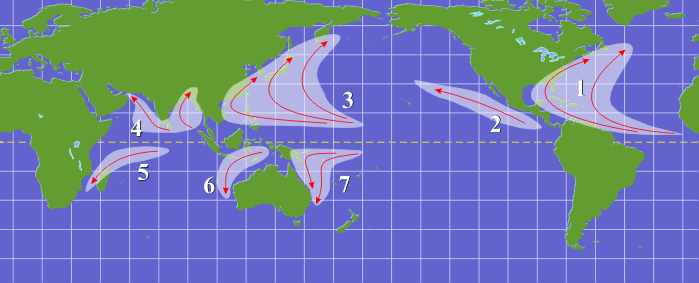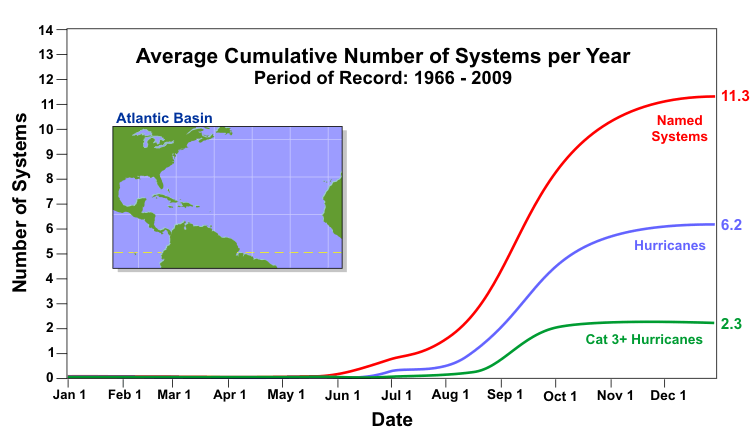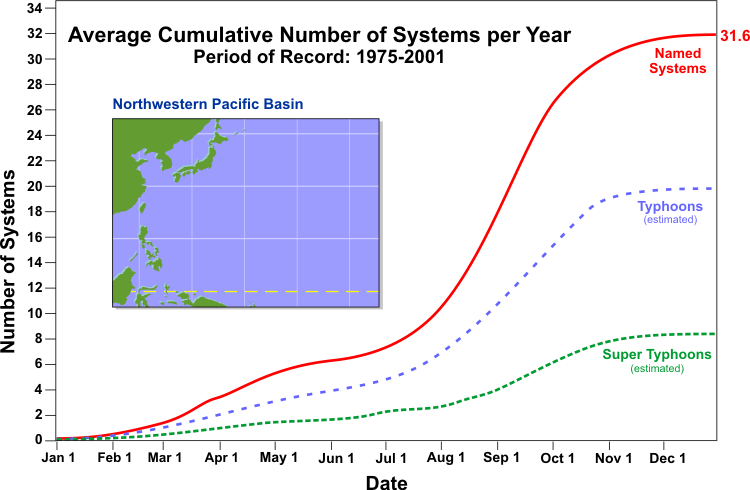Prioritize...
When you've completed this section, you should be able to describe where tropical cyclones do (and don't) form globally, and the primary reason why. You should also be able to identify the most active tropical basins and describe the "seasons" (when tropical cyclones are most likely to form) in the North Atlantic, Northeast Pacific, and Northwest Pacific Basins.
Read...
Although we generically defined tropical cyclones as low-pressure systems that form over warm tropical seas, do they just form anywhere in the tropics? Not really. As you can see from the image below, the breeding grounds and regions where tropical cyclones typically track can be boiled down to seven areas:
- Atlantic Basin (the northern Atlantic Ocean, the Gulf of Mexico, and the Caribbean Sea)
- Northeast Pacific Basin (from Mexico to the International Dateline)
- Northwest Pacific Basin (from the International Dateline to Asia, including the South China Sea)
- North Indian Basin (includes the Bay of Bengal and the Arabian Sea)
- Southwest Indian Basin (from Africa to about 100 degrees east longitude)
- Southeast Indian/Australian Basin (100 degrees east longitude to 142 degrees east longitude)
- Australian/Southwest Pacific Basin (142 degrees longitude to about 120 degrees west longitude)

Of these seven areas, the Northwest Pacific and Northeast Pacific basins tend to be the busiest, as this frequency plot for tropical cyclones suggests. It shows the average number of occurrences (from 1972 to 2001) that the center of a tropical cyclone occupied an area with dimensions of one degree latitude by one degree longitude. The dark red color indicates the highest average of such occurrences, and thus marks the core of these breeding basins for tropical cyclones. Meanwhile, some areas in the tropics are nearly entirely free of tropical cyclones. While tropical cyclones can form outside of the seven areas listed above, it happens relatively infrequently. For example, the southern Atlantic Ocean (south of the equator) is rarely home to tropical cyclones. Note also that tropical cyclones do not form near the equator, for reasons that we'll discuss later in the lesson.
Why do tropical cyclones typically form in these areas and not elsewhere in the tropics? Well, for starters, tropical cyclones are driven by thunderstorms which require warm, moist air to flourish. Sufficiently warm, moist air is most often found where ocean waters are warm, having sea-surface temperatures of at least 26.5 degrees Celsius, or about 80 degrees Fahrenheit. Other factors are required for tropical cyclone development, too, and these ingredients most commonly come together with warm ocean waters in the seven areas described above.
Although we'll soon cover all of the ingredients needed for tropical cyclones, their reliance on warm ocean waters explains quite a bit about where and when tropical cyclones form. The image below shows the running tally of the average number of named storms, hurricanes, and major hurricanes over the North Atlantic. Although "official" hurricane season runs from June 1 to November 30, tropical systems have been observed during "non-official" months. So there is nothing magical about the start and end dates of the Atlantic hurricane season. Still, the official hurricane season historically captures 97% of all tropical cyclone activity in the Atlantic, so "official" carries some weight in this situation.

Why do the vast majority of tropical cyclones form between June and November in the Atlantic? One big reason is that's the time of year when large expanses of the ocean are favorably warm for fueling tropical thunderstorms, which can develop into tropical cyclones. When we look at long-term average sea-surface temperatures in the North Atlantic Ocean from June to November, we see a broad corridor of surface water with temperatures of at least 26.5 degrees Celsius extending from the western coast of Africa across the tropical and subtropical Atlantic. And, if you refer back to the figure showing typical breeding grounds for tropical cyclones, you'll see that this warm swath of water lines up pretty well with the common area for tropical cyclone activity in the North Atlantic basin.
The running tally of the average number of storms during a typical Atlantic hurricane season (above) also indicates that there is a fairly sharp increase in named storms between August and October. Some forecasters refer to this as the "real" hurricane season within the official hurricane season because, historically, August-October contains 78 percent of the days when at least one tropical storm was observed over the Atlantic basin (sometimes referred to as "tropical-storm days"). Moreover, this period contains 87 percent of the "hurricane days" and 96 percent of the "major-hurricane days". Not surprisingly, higher sea-surface temperatures prevail over a larger area during this highly active period.
Statistically, the most active time in the North Atlantic Basin is early to mid-September. To drive home my point, check this plot showing the daily occurrence of tropical storms, minor hurricanes (Category 1 or 2), and intense (major) hurricanes using data spanning from 1886 to 1991. Not surprisingly, early to mid-September corresponds to the time when ocean temperatures peak. The climatological spike in sea-surface temperatures also helps explain why September has the highest probability of major hurricanes developing over the tropical Atlantic. Of course, I should remind you that about three percent of the tropical cyclone activity in the North Atlantic occurs outside of hurricane season, and tropical cyclones have been observed in the Atlantic basin in every month of the year, with January through April being the least active.
Needless to say, sea-surface temperatures govern hurricane seasons in the other basins, as well. In the eastern North Pacific, hurricane season runs from May 15 to November 30. This basin gets off to a faster start than the North Atlantic, owing largely to the pool of warmer water along the west coast of Central America (check out the long-term means of sea-surface temperatures from May 15 to May 31), and really ramps up from July through October.
The Northwest Pacific basin is unlike other tropical basins in that it "never sleeps." Its tropical cyclone season spans the entire year, which makes sense since annual sea-surface temperature averages clearly support year-round activity. The Northwest Pacific is the most active basin in the world, with an annual average of more than 30 named storms (see image below).

The Northwest Pacific does tend to be less active during the first half of the year, with the greatest flurry of activity occurring between mid-July and mid-October, on average (when sea-surface temperatures are even higher). So, even though the season technically spans the entire year, most of the activity occurs from July through October, with a peak in August and September.
I won't go into the detailed climatologies of the other tropical basins because I hope you get the basic idea by now. The bottom line is that the climatological statistics clearly show the link between high sea-surface temperatures and the development of tropical cyclones. However, I do want to emphasize the point that high sea-surface temperatures are necessary, but not sufficient by themselves, to guarantee the development of tropical cyclones. Other ingredients must be present in order to create a tropical cyclone (which we'll cover shortly).
Ultimately, between 80 and 90 named tropical cyclones (meaning at least tropical-storm strength) form across the globe, on average, each year. Of these, about 60 percent become hurricanes, on average. But, why exactly do tropical storms and hurricanes receive names in the first place? We'll investigate up next.